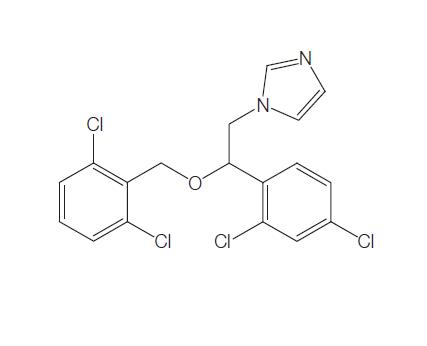Mechanism of action of Isoconazole
Mar 29,2022
Isoconazole is an imidazole derivative, structurally related to clotrimazole. It has the chemical name 1-[2,4- dichloro-b-[(2,6-dichlorobenzyl)oxy]phenethyl]imidazole nitrate. Isoconazole has a broad spectrum of antifungal activity in vitro and has been shown to be an effective agent for the management of vaginal candidiasis.

Mechanism of action
The mechanism of action of isoconazole is assumed to be similar to that of the other N-substituted imidazole derivatives.
The mechanism of action of isoconazole is assumed to be similar to that of the other N-substituted imidazole derivatives.
Pharmacokinetics and Pharmacodynamics
Topical application of 1% isoconazole nitrate cream to the forearms of volunteers resulted in high levels of the drug in the horny layer 10 days after the treatment. This large and longlasting reservoir of isoconazole in the horny layer of the skin may provide protection of the skin against new infection. Negligible systemic absorption of isoconazole is said to occur following intravaginal insertion of two 300-mg pessaries. Fungicidal concentrations of isoconazole persist in the vagina for 3 days after a single dose of 600 mg inserted intravaginally.
Toxicity
Local reactions include vaginal burning and itching. Contact dermatitis has been reported (Frenzel and Gutekunst, 1983), including an unusual case with a papulopustular reaction.
Clinical uses
An 80–90% clinical and mycologic cure rate was achieved with intravaginal administration of 600 mg isoconazole nitrate in women with vaginal candidiasis, and an open comparative study of isoconazole and oral ketoconazole found no difference in efficacy between the two treatments. Single-dose isoconazole was found to be similar to oral ketoconazole (300 mg) and oral fluconazole (150 mg; 82.5%, 86.6%, and 91.8%, respectively, pW0.05) in a small comparative study of reproductive-age women with candidal vaginitis.
Similar efficacy has been shown for isoconazole nitrate 600 mg and econazole 300 mg given as a single dose as treatment for vaginal candidosis with cure rates of 78% and 70%, respectively, at 14 days after intravaginal administration, and sustained cure rates of 65% and 64%, respectively, at 4 weeks. Equivalent mycologic and clinical efficacy was also established for isoconazole administered as a single dose of 600 mg and clotrimazole as a single dose of 500 mg.
- Related articles
- Related Qustion
Flutrimazole is an imidazole derivative with the chemical name 1- [o-fluoro-a-(p-fluorophenyl)-a-phenylbenzyl]imidazole; the chemical structure is shown in Figure 148.1. Flutrimazole has a broad spectrum of antifungal activity in vitro and....
Mar 29,2022API1,2-phenylenediamine appears as colorless monoclinic crystals if pure; technical grade brownish-yellow crystals or a sandy brown solid. Used in manufacture of dyes, photography, organic synthesis.1,2-....
Mar 30,2022Drugs




